Red Hat Insights Remediations Guide
Fixing issues on RHEL systems with remediation playbooks
Abstract
Chapter 1. Remediations overview
After identifying the highest remediation priorities in your Red Hat Enterprise Linux (RHEL) infrastructure, you can create, and then execute, remediation playbooks to fix those issues.
Subscription requirements
- Red Hat Insights for Red Hat Enterprise Linux is included with every RHEL subscription. No additional subscriptions are required to use Insights remediation features.
User requirements
- Access remediation capabilities in the Insights for Red Hat Enterprise Linux application on the Red Hat Hybrid Cloud Console (Hybrid Cloud Console).
- Access Red Hat Satellite-managed systems in the Console or in the Satellite application UI.
- All Insights users will automatically have access to read, create, and manage remediation playbooks.
- The ability to execute playbooks on remote systems requires the Remediations administrator predefined User Access role, granted by an Organization Administrator in Identity & Access Management settings on the Hybrid Cloud Console.
1.1. User Access settings in the Red Hat Hybrid Cloud Console
User Access is the Red Hat implementation of role-based access control (RBAC). Your Organization Administrator uses User Access to configure what users can see and do on the Red Hat Hybrid Cloud Console (the console):
- Control user access by organizing roles instead of assigning permissions individually to users.
- Create groups that include roles and their corresponding permissions.
- Assign users to these groups, allowing them to inherit the permissions associated with their group’s roles.
1.1.1. Predefined User Access groups and roles
To make groups and roles easier to manage, Red Hat provides two predefined groups and a set of predefined roles.
1.1.1.1. Predefined groups
The Default access group contains all users in your organization. Many predefined roles are assigned to this group. It is automatically updated by Red Hat.
If the Organization Administrator makes changes to the Default access group its name changes to Custom default access group and it is no longer updated by Red Hat.
The Default admin access group contains only users who have Organization Administrator permissions. This group is automatically maintained and users and roles in this group cannot be changed.
On the Hybrid Cloud Console navigate to Red Hat Hybrid Cloud Console > the Settings icon (⚙) > Identity & Access Management > User Access > Groups to see the current groups in your account. This view is limited to the Organization Administrator.
1.1.1.2. Predefined roles assigned to groups
The Default access group contains many of the predefined roles. Because all users in your organization are members of the Default access group, they inherit all permissions assigned to that group.
The Default admin access group includes many (but not all) predefined roles that provide update and delete permissions. The roles in this group usually include administrator in their name.
On the Hybrid Cloud Console navigate to Red Hat Hybrid Cloud Console > the Settings icon (⚙) > Identity & Access Management > User Access > Roles to see the current roles in your account. You can see how many groups each role is assigned to. This view is limited to the Organization Administrator.
See User Access Configuration Guide for Role-based Access Control (RBAC) for additional information.
1.1.2. Access permissions
The Prerequisites for each procedure list which predefined role provides the permissions you must have. As a user, you can navigate to Red Hat Hybrid Cloud Console > the Settings icon (⚙) > My User Access to view the roles and application permissions currently inherited by you.
If you try to access Insights for Red Hat Enterprise Linux features and see a message that you do not have permission to perform this action, you must obtain additional permissions. The Organization Administrator or the User Access administrator for your organization configures those permissions.
Use the Red Hat Hybrid Cloud Console Virtual Assistant to ask "Contact my Organization Administrator". The assistant sends an email to the Organization Administrator on your behalf.
1.1.3. User Access roles for remediations users
The following roles enable standard or enhanced access to remediations features in Insights for Red Hat Enterprise Linux:
- Remediations user. The Remediations user role is included in the Default access group. The Remediation user role permits access to view existing playbooks for the account and to create new playbooks. Remediations users cannot execute playbooks on systems.
- Remediations administrator. The Remediations administrator role permits access to all remediations capabilities, including remotely executing playbooks on systems.
Chapter 2. Enabling host communication with Insights
Before you can execute playbooks on remote systems from Red Hat Insights for Red Hat Enterprise Linux, your systems have to be able to communicate with Red Hat Insights.
- For Red Hat Enterprise Linux systems that are not managed by Red Hat Satellite, you should follow the procedure below to enable the rhc client on those systems.
- For systems that are managed by Satellite, you will configure Cloud Connector on the host servers for those systems. :context: host-communication-with-insights
2.1. Enabling the rhc client on systems directly managed by Insights
To be able to execute remediation playbooks from Insights for Red Hat Enterprise Linux, the rhc client must be enabled on the systems in your infrastructure. The rhc connect command does this by registering (RHEL8.6 and later, and 9.0 and later) systems with Red Hat Subscription Manager and Red Hat Insights, and enabling remote host configuration (rhc) features in Insights for Red Hat Enterprise Linux.
Prerequisites
- Sudo access on the Red Hat Enterprise Linux host system
Connect rhc on RHEL8.5 systems
Remote host configuration on RHEL 8.5 has dependencies of ansible and rhc-worker-playbook. To install the dependencies, you must first register with Subscription Manager.
Use the following commands to enable rhc on RHEL 8.5 systems.
[root]# subscription-manager repos --enable ansible-2.9-for-rhel-8-x86_64-rpms [root]# dnf -y install ansible rhc-worker-playbook-0.1.5-3.el8_4 [root]# rhc connect
Connect rhc on RHEL8.6 and later systems
Use the following commands to enable rhc on RHEL8.6 and later systems.
[root]# dnf -y update rhc [root]# dnf -y install rhc-worker-playbook [root]# rhc connect
Connect rhc on RHEL9.0 and later systems
Use the following commands to enable rhc on RHEL9.0 and later systems.
[root]# dnf -y install rhc rhc-worker-playbook [root]# rhc connect
Additional resources
- After enabling rhc, you can manage the configuration at Red Hat Hybrid Cloud Console > Red Hat Insights > Inventory > System Configuration > Remote Host Configuration (RHC).
- For complete rhc documentation, see Remote Host Configuration and Management.
2.2. Enabling Cloud Connector for content hosts managed by Satellite
You can remediate issues on Satellite-managed content hosts remotely from the Insights for Red Hat Enterprise Linux user interface in the Red Hat Hybrid Cloud Console. Remote remediation from Insights requires that your first configure the Cloud Connector plugin on the Satellite Server.
If you want to manage and execute host remediations completely from the Satellite web console, then you do not need to enable the Cloud Connector plugin.
The following prerequisites are comprehensive for Satellite Server configuration:
Prerequisites
- Satellite must be version 6.9 or later.
- You have root access to the Satellite server.
- The content hosts that are managaged by the satellite should have the Insights client installed and turned on. See the reference section of this documentation for Insights client installation and enablement procedures.
- Import a Subscription Manifest into Satellite. For more information, see Importing a Subscription Manifest into Satellite Server in the Red Hat Satellite Content Management Guide.
- Register your hosts to Satellite using an activation key to attach Red Hat subscriptions. For more information, see Registering Hosts in the Red Hat Satellite Managing Hosts guide.
2.2.1. Configuring Cloud Connector and uploading your Satellite Server content host inventory to Red Hat Insights
Before you can run remediation playbooks remotely from Insights, you must install and configure the Cloud Connector plugin on Satellite Server. Perform the following tasks to install, configure, and verify the configuration of Cloud Connector.
Procedure
On Satellite Server, enable the
remote-executionplugin by entering one of the following commands, based on your version of Satellite Server.On Satellite Server 6.12 and newer
[root]# satellite-installer --foreman-proxy-plugin-remote-execution-script-install-key true
On Satellite Server 6.9 - 6.11
[root]# satellite-installer --foreman-proxy-plugin-remote-execution-ssh-install-key true
NoteConfiguring Cloud Connector requires that the satellite perform a remote execution on itself. This is why the first step is to enable the
remote-executionscript or plugin.
- In the Satellite Server web UI, navigate to Configure > Red Hat Cloud > Inventory Upload. Verify that the Automatic Inventory Upload switch is turned ON, which is the default setting.
Optionally: Toggle the Obfuscate host names switch to the ON position to hide host names that Satellite Server reports to the Hybrid Cloud Console.
NoteThe Obfuscate host names setting only affects
rh_cloudreports. If you want to obfuscate hostnames and IP addresses, you should set obfuscation in the Insights client configuration. Satellite knows how to read this configuration, and will follow along. See Client Configuration Guide for Red Hat Insights sections, Obfuscating the host name and Obfuscating the IPv4 address.Automatic inventory upload and Obfuscate host names are global settings. They affect content hosts that belong to all organizations.
- Click Configure Cloud Connector. A Notice dialog box warns you that this action also enables auto reports upload. Click Confirm.
- Wait for the task to finish. This should take about one minute. Go to Monitor > Jobs > Configure Cloud Connector to see the job.
Eventually, you will see the satellite in Red Hat Hybrid Cloud Console > the Settings icon (⚙) > Integrations, in the Red Hat tab. Allow up to one hour after the job is visible in the Satellite web console.
+ The bottom of the Inventory Uploads page shows the name of your organization; hovering over it will turn the area grey. Clicking on the name will cause it to expand, showing a Generating tab and Uploading tab where one can monitor the progress of the upload. . Click Restart to generate a data payload from each of the content hosts that have Insights client running, and upload your host inventory to Insights for Red Hat Enterprise Linux.
+ Repeat this step, clicking Restart for each organization for which you want to upload a content host inventory. . Set Auto sync for the organization under Configure > Red Hat Cloud (after Sat 6.11) > Insights using the toggle in the upper right of the screen.
Verification
To verify that the upload was successful, log into Red Hat Hybrid Cloud Console > Red Hat Enterprise Linux > Red Hat Insights > Inventory and search for the satellite_id tag for your content hosts.
Optionally, push the Sync inventory status button and wait for the task to finish. It will show you the number of content hosts recognized by Insights inventory.
Chapter 3. Creating and managing remediation playbooks in Insights
The workflow to create playbooks is similar in each of the services in Insights for Red Hat Enterprise Linux. In general, you will fix one or more issues on a system or group of systems.
Playbooks focus on issues identified by Insights services. A recommended practice for playbooks is to include systems of the same RHEL major/minor versions because the resolutions will be compatible.
3.1. Creating a playbook to remediate a CVE vulnerability on RHEL systems
Create a remediation playbook in the Red Hat Insights vulnerability service. The workflow to create a playbook is similar for other services in Insights for Red Hat Enterprise Linux.
Prerequisites
- You are logged into the Red Hat Hybrid Cloud Console.
No enhanced User Access permissions are required to create remediation playbooks.
Procedure
- Navigate to the Security > Vulnerability > CVEs page.
- Set filters as needed and click on a CVE.
- Scroll down to view affected systems.
Select systems to include in a remediation playbook by clicking the box to the left of the system ID.
NoteInclude systems of the same RHEL major/minor version, which you can do by filtering the list of affected systems.
- Click the Remediate button.
Select whether to add the remediations to an existing or new playbook and take the following action:
- Click Add to existing playbook and select the desired playbook from the dropdown list, OR
- Click Create new playbook and add a playbook name.
- Click Next.
- Review the systems to include in the playbook, then click Next.
Review the information in the Remediation review summary.
- By default, autoreboot is enabled. You can disable this option by clicking Turn off autoreboot.
- Click Submit.
Verification step
- Navigate to Automation Toolkit > Remediations.
- Search for your playbook. You should see your playbook.
3.1.1. Creating playbooks to remediate CVEs with security rules when recommended and alternate resolution options exist
Most CVEs in Red Hat Insights for RHEL will have one remediation option for you to use to resolve an issue. Remediating a CVE with security rules might include more than one resolution a recommended and one or more alternate resolutions. The workflow to create playbooks for CVEs that have one or more resolution options is similar to the remediation steps in the advisor service.
For more information about security rules, see Security rules , and Filtering lists of systems exposed to security rules in Assessing and Monitoring Security Vulnerabilities on RHEL Systems .
Prerequisites
- You are logged into the Red Hat Hybrid Cloud Console.
You do not need enhanced User Access permissions to create remediation playbooks.
Procedure
- Navigate to Security > Vulnerability > CVEs.
Set filters if needed (for example, filter to see CVEs with security rules to focus on issues that have elevated risk associated with them). Or, click the CVEs with security rules tile on the dashbar. Both options show in the example image.
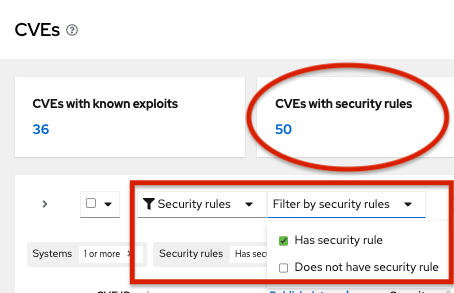
-
Click a CVE in the list.

Scroll to view affected systems, and select systems you want to include in a remediation playbook by clicking the box to the left of the system ID on the Review systems page. (Selecting one or more systems activates the Remediate button.)
NoteRecommended: Include systems of the same RHEL major or minor version by filtering the list of affected systems.
- Click Remediate.
Decide whether to add the remediations to an existing or new playbook by taking one of the following actions:
- Choose Add to existing playbook and select the desired playbook from the dropdown list, OR
- Choose Create new playbook, and add a playbook name. For this example, HCCDOC-392.
- Click Next. A list of systems shows on the screen.
- Review the systems to include in the playbook (deselect any systems that you do not want to include).
Click Next to see the Review and edit actions page, which shows you options to remediate the CVE. The number of items to remediate can vary. You will also see additional information (that you can expand and collapse) about the CVE, such as:
- Action: Shows the CVE ID.
- Resolution: Displays the recommended resolution for the CVE. Shows if you have alternate resolution options.
- Reboot required: Shows whether you must reboot your systems.
- Systems: Shows the number of systems you are remediating.
On the Review and edit actions page, choose one of two options to finish creating your playbook:
Option 1: To review all of the recommended and alternative remediation options available (and choose one of those options):
- Select Review and/or change the resolution steps for this 1 action or similar based on your actual options.
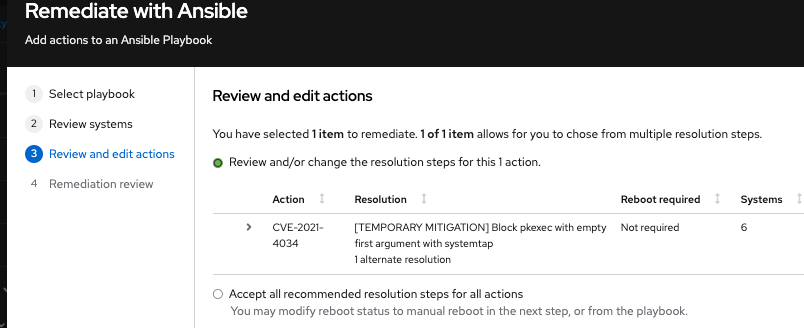
- Click Next.
On the Choose action: <CVE information> page, click a tile to select your preferred remediation option. The bottom edge of the tile highlights when you select it. The recommended solution is highlighted by default.
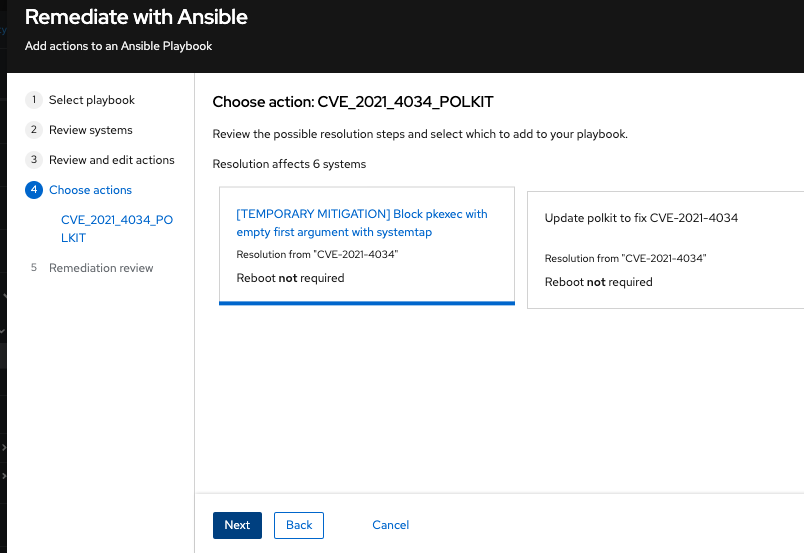
Click Next.
Option 2: To accept all recommended remediations:
- Choose Accept all recommended resolutions steps for all actions.
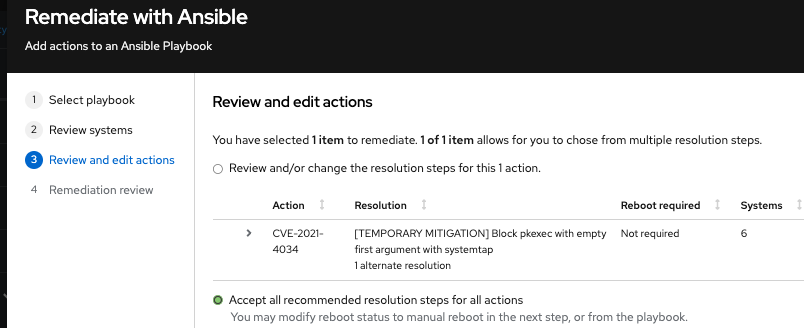
Review information about your selections and change options for autoreboot of systems on the Remediations review page. The page shows you the:
- Issues you are adding to your playbook.
- Options for changing system autoreboot requirements.
Summary about CVEs and resolution options to fix them.
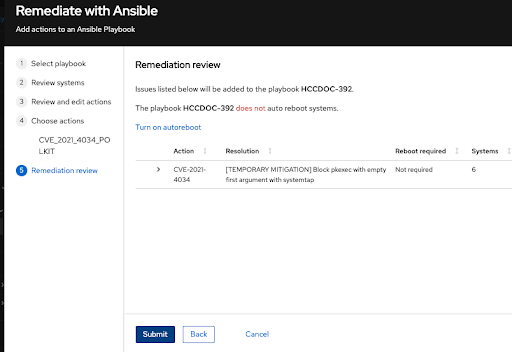
- Optional. Change autoreboot options on the Remediation review page, if needed. (Autoreboot is enabled by default, but your settings might vary based on your remediation options.)
- Click Submit. A notification displays that shows the number of remediation actions added to your playbook, and other information about your playbook.
Verification step
- Navigate to Automation Toolkit > Remediations.
- Search for your playbook.
- To run (execute) your playbook, see Executing remediation playbooks from Insights for Red Hat Enterprise Linux.
3.2. Managing remediation playbooks in Insights for Red Hat Enterprise Linux
You can download, archive, and delete existing remediation playbooks for your organization. The following procedures describe how to perform common playbook-management tasks.
Prerequisites
- You are logged into the Red Hat Hybrid Cloud Console.
No enhanced permissions are required to view, edit, or download information about existing playbooks.
3.2.1. Downloading a remediation playbook
Use the following procedure to download a remediation playbook from the Insights for Red Hat Enterprise Linux application.
Procedure
- Navigate to Automation Toolkit > Remediations.
- Locate the playbook you want to manage and click on the name of the playbook. The playbook details are visible.
- Click the Download playbook button to download the playbook YAML file to your local drive.
3.2.2. Archiving a remediation playbook
You can archive a remediation playbook that is no longer needed, but the details of which you want to preserve.
Procedure
- Navigate to Automation Toolkit > Remediations.
- Locate the playbook you want to archive.
- Click on the options icon (⋮) and select Archive playbook. The playbook is archived.
3.2.3. Viewing archived remediation playbooks
You can view archived remediation playbooks in Insights for Red Hat Enterprise Linux.
Procedure
- Navigate to Automation Toolkit > Remediations.
-
Click the More options icon
 that is to the right of the Download playbook button and select Show archived playbooks.
that is to the right of the Download playbook button and select Show archived playbooks.
3.2.4. Deleting a remediation playbook
You can delete a playbooks that is no longer needed.
Procedure
- Navigate to Automation Toolkit > Remediations.
- Locate and click on the name of the playbook you want to delete.
-
On the playbook details page, click the More options icon
 and select Delete.
and select Delete.
3.2.5. Monitoring remediation status
You can view the remediation status for each playbook that you execute from the Insights for Red Hat Enterprise Linux remediations service. The status information tells you the results of the latest activity and provides a summary of all activity for playbook execution. You can also view log information for playbook execution.
Prerequisites
- You are logged into the Red Hat Hybrid Cloud Console.
Procedure
- Navigate to Automation Toolkit > Remediations. The page displays a list of remediation playbooks.
- Click on the name of a playbook.
- From the Actions tab, click any item in the Status column to view a pop-up box with the status of the resolution.
To monitor the status of a playbook in the Satellite web UI, see Monitoring Remote Jobs in the Red Hat Satellite Managing Hosts guide.
Chapter 4. Executing remediation playbooks
After you create a remediation playbook, you can download and run the playbook using your organization’s Ansible workflow, or execute the playbook on remote systems from the Insights for Red Hat Enterprise Linux application.
4.1. Executing remediation playbooks from the Insights User Interface
You can execute remediation playbooks directly from the Red Hat Insights UI on the Red Hat Hybrid Cloud Console. You must complete four prerequisites before you can do so. Detailed instructions for completing the prerequisites follow the main procedure.
Prerequisites
- You must be logged in to the Red Hat Hybrid Cloud Console.
- You must enable the Remote Host Configuration client (rhc connect) in the command line.
- You must enable Remote Host Configuration Manager in the UI.
- You must be a member of a User Access group with the Remediations administrator role.
The Remediations administrator role is NOT a default role. You must create the group and add yourself to the group. For more information about User Access permissions, see the following: Managing group access with roles and members
Procedure
- Navigate to Automation Toolkit > Remediations.
- Select a remediation playbook by clicking the playbook name.
- Click Execute playbook.
- On the popup menu, click Execute playbook on systems. The playbook runs on those systems.
If Execute playbook is disabled, you need to satisfy the prerequisites listed above to use this feature. Alternately, you can hover your cursor over Execute playbook and you will see the Remediations Readiness Check tooltip. The tooltip identifies prerequisites that are not complete. Click the incomplete prerequisite and follow the link for further instructions or you can see the detailed procedures below.
Additional resources
User Access Configuration Guide for Role-based Access Control (RBAC)
4.1.1. Enabling Remote Host Configuration client (RHC connect) in the command line
You must run RHC client (rhc connect) in the command line to enable host communication. Follow this procedure to learn if your host is connected:
Procedure
- Navigate to Automation Toolkit > Remediations.
- Choose the remediation playbook you want to run.
- Click on the Systems tab and view the Connection Status to the right of your remediation.
If your Connection Status is Unknown, this means you do not have the correct User Access permissions to view the status. Click the ? icon to the left to learn how to change User Access permissions to view this data.
Additional Resources
For more information on the rhc connect command, see the following: Enabling the rhc client on systems directly managed by Insights
4.1.2. Enabling Remote Host Configuration Manager in the UI
You must enable Remote Host Configuration Manager in the UI to execute remediation playbooks. Complete the following steps:
Procedure
- Navigate to Remote Host Configuration Manager.
- Locate the Permission section on the left, look at the first option, Allow Insights users to use Remediations to send Ansible Playbooks to fix issues on your systems.
- If Disabled is selected, click Change settings on the left side of your screen.
- Change the Status toggle to Enabled.
- Click Save changes on the left side of your screen.
- A Changes saved confirmation box will appear at the top right corner of your screen.
4.2. Executing remediations from the Satellite User Interface
You can also remediate using the Satellite User Interface.
Prerequisites
- You are a Cloud Administrator.
- You are a Remediations Administrator.
- You have completed Host registration using the Insights client.
For specific instructions, see Creating an Insights Remediation Plan for Hosts in the Satellite Managing Hosts documentation.
When you introduce a new host into your Satellite inventory, by means of provisioning or registration, two automatic background tasks will initiate. It will take 24 hours for these tasks to complete. This is a typical time frame for the automatic synchronization.
If you identify security issues or another scenario that warrants not waiting 24 hours for the automatic sync, you can manually synchronize by clicking the sync button in the UI. This manual sync will complete in a few minutes.
To see the procedures for enabling automatic and manual synchronization, see the Configuring Synchronization of Insights Recommendations for Hosts in the Satellite documentation.
Chapter 5. Using patch templates for remediations
The Red Hat Insights patch application supports scheduled patching cycles.
Patch templates do not affect yum/dnf operations on the host, but they allow you to refine your patch status reporting in Red Hat Insights. You can use the templates to create remediation playbooks for simple patch cycles.
5.1. Using patch templates with remediations
Patch templates can include one or more remediations that you want to apply to multiple systems. You can create a patch template to update a group of systems in a test environment, and use the same patch template to update systems in a production environment on a different day.
For more information about creating and using patch templates with remediations, refer to System Patching Using Remediation Playbooks.
After you apply a patch template to the systems you assign, you will not see more recently published advisories that apply to those systems. Use Red Hat Hybrid Cloud Console notifications to ensure that you remain aware of newly published advisories that might affect your infrastructure.
For more information about notifications in the Red Hat Hybrid Cloud Console, see Configuring notifications on the Red Hat Hybrid Cloud Console.
Chapter 6. Reference
The following topic are related to the configuration, creation, and management of Insights remediation playbooks.
6.1. Installing the Insights client on Satellite Server content hosts
The Insights client comes preinstalled on most versions of Red Hat Enterprise Linux; however, if you have to install it, use this procedure to install the Insights client on each system.
Prerequisites
Register your hosts to Satellite
If you already have Red Hat Enterprise Linux hosts, you can use the Global Registration Template to register them to Satellite. For more information, see Registering hosts to Satellite.
Procedure
Install the Insights for Red Hat Enterprise Linux client:
# yum install insights-client
Register the host to Insights for Red Hat Enterprise Linux:
# insights-client --register
- Repeat these steps on each host.
Alternatively, you can use the RedHatInsights.insights-client Ansible role to install the Insights client and register the hosts. For more information, see Using Red Hat Insights with Hosts in Satellite in the Red Hat Satellite Managing Hosts guide.
6.2. Configuring Cloud Connector after upgrading Satellite Server 6.10 to 6.11
This only applies to upgrades from Satellite version 6.10 to 6.11. Refer to the Upgrading and Updating Red Hat Satellite guide for more information.
To configure Cloud Connector after upgrading the Satellite Server, click Configure Cloud Connector button from Configure > RH Cloud - Inventory Upload to enable it on the new version of Satellite Server. Simultaneously, you are required to remove the previous source from the cloud manually on the Red Hat Hybrid Cloud Console after upgrading your Satellite Server.
Once the Cloud Connector is configured, it will remove the receptor bits and install the RHC bits. At the same time, the Cloud Connector announces all the organizations in the Satellite to the source and is ready to receive the connections.
6.3. Disabling direct remediations on a Satellite Server content host
By default the parameter is not set on each host. It is True for the hostgroup to allow the execution of playbooks by default on the Cloud Connector. Note that all the hosts that are present in that particular organization inherit the same parameters.
When the Satellite receives the remediation playbook run request from Cloud Connector, that request has a list of hosts where it should execute.
Complete the following step to ensure the playbook run does not get invoked from the cloud on a single host.
Procedure
- Go to Hosts menu > All Hosts in the Satellite web UI.
-
Locate the host and click the Edit button > Parameters tab and set the
enable_cloud_remediationsparameter to False on that host.
6.4. Disabling direct remediation on a Satellite Server content host group
By default the parameter is not set in the system. It is True for the host group to allow the execution of playbooks by default with the Cloud Connector.
All the hosts that are present in that particular organization will inherit the same parameters.
Optionally, an Organization Administrator can disable the cloud remediations for the whole organization or host group. To disable remediations, change the Global Parameter in the Red Hat Satellite User Interface. Use the following steps to make this edit.
Procedure
- Navigate to the Satellite Dashboard.
- Click Configure on the left navigation.
- Click Global Parameters.
- Click Create Parameter.
-
In the Name field, enter
enable_cloud_remediations. -
In the Value field, enter
false. - Click Submit.
Verification step
Find your new parameter listed in the Global Parameters table.
Providing feedback on Red Hat documentation
We appreciate and prioritize your feedback regarding our documentation. Provide as much detail as possible, so that your request can be quickly addressed.
Prerequisites
- You are logged in to the Red Hat Customer Portal.
Procedure
To provide feedback, perform the following steps:
- Click the following link: Create Issue
- Describe the issue or enhancement in the Summary text box.
- Provide details about the issue or requested enhancement in the Description text box.
- Type your name in the Reporter text box.
- Click the Create button.
This action creates a documentation ticket and routes it to the appropriate documentation team. Thank you for taking the time to provide feedback.